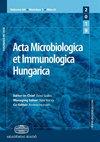Rapid detection of carbapenemase-producing gram-negative bacteria directly from blood culture bottles for a reliable guided empiric therapy.
IF 1.6
4区 医学
Q4 IMMUNOLOGY
引用次数: 0
Abstract
Bloodstream infections (BSIs) caused by multidrug-resistant bacteria are a critical life-threatening challenge which necessitates the urgency to trigger life-saving treatment in a timely manner. This study aimed to evaluate the time required for rapid detection of carbapenemase-producing Enterobacterales (CPE) directly from blood culture bottles to optimize empirical treatment of BSI, especially in pediatric and infant patients, using a cost-effective method. This study included 419 Gram-negative bacteria, of which Klebsiella pneumoniae and Escherichia coli were the most common CPE causing BSI in pediatric and neonatal patients. Phenotypic and genotypic resistance of the selected isolates (45 K. pneumoniae and 9 E. coli) were determined by VITEK-2 Compact system and PCR, respectively. BACT/ALERT bottles were spiked with isolates. Finally, colorimetric RESIST-BC assay and Vitek-2 compact system were evaluated for the rapid detection of carbapenem-resistant bacteria directly from positive blood culture bottles. All selected isolates were phenotypically resistant to carbapenems. PCR showed that blaNDM and blaOXA-48 were present in all isolates, blaVIM was present in 44.4%, while blaKPC and blaIMP were entirely absent. The RESIST-BC kit showed good agreement with PCR for blaNDM and blaOXA-48, demonstrating high sensitivity and specificity, but not with blaVIM. These findings point out that RESIST-BC assay demonstrated an exceptionally short detection time for CPE, completing all cases within the first hour after the blood culture bottles flagged positive. It is also superior in providing a clue for clinicians on antibiotic combinations that can be administered, depending on the type of β-lactamases detected, promptly and efficiently, with low expenses.直接从血液培养瓶中快速检测产碳青霉烯酶的革兰氏阴性菌,为经验疗法提供可靠的指导。
由多重耐药菌引起的血流感染(BSI)是威胁生命的重大挑战,因此迫切需要及时启动救命治疗。本研究旨在评估直接从血培养瓶中快速检测产碳青霉烯酶肠杆菌(CPE)所需的时间,从而采用经济有效的方法优化 BSI 的经验性治疗,尤其是在儿科和婴幼儿患者中。这项研究包括 419 种革兰氏阴性菌,其中肺炎克雷伯菌和大肠埃希菌是导致儿科和新生儿患者 BSI 的最常见 CPE。所选分离菌株(45 株肺炎克雷伯菌和 9 株大肠埃希菌)的表型和基因型耐药性分别由 VITEK-2 Compact 系统和 PCR 测定。在 BACT/ALERT 瓶中添加分离物。最后,对直接从阳性血培养瓶中快速检测碳青霉烯耐药菌的比色 RESIST-BC 检测法和 VITEK-2 Compact 系统进行了评估。所有被选中的分离菌都对碳青霉烯类具有表型耐药性。PCR 结果显示,所有分离株中都存在 blaNDM 和 blaOXA-48,44.4% 存在 blaVIM,而完全不存在 blaKPC 和 blaIMP。在 blaNDM 和 blaOXA-48 的检测中,RESIST-BC 检测试剂盒与 PCR 的检测结果一致,显示出较高的灵敏度和特异性,但在 blaVIM 的检测中,RESIST-BC 检测试剂盒与 PCR 的检测结果不一致。这些研究结果表明,RESIST-BC 检测法对 CPE 的检测时间非常短,在血培养瓶呈阳性后的第一个小时内就能完成所有病例的检测。它还能根据检测到的β-内酰胺酶类型为临床医生提供抗生素组合的线索,既迅速又高效,而且费用低廉。
本文章由计算机程序翻译,如有差异,请以英文原文为准。
求助全文
约1分钟内获得全文
求助全文
来源期刊

Acta microbiologica et immunologica Hungarica
IMMUNOLOGY-MICROBIOLOGY
CiteScore
2.30
自引率
13.30%
发文量
36
审稿时长
>12 weeks
期刊介绍:
AMIH is devoted to the publication of research in all fields of medical microbiology (bacteriology, virology, parasitology, mycology); immunology of infectious diseases and study of the microbiome related to human diseases.
 求助内容:
求助内容: 应助结果提醒方式:
应助结果提醒方式:


